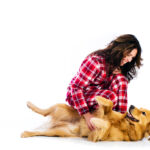Why Do Dogs Not Like Cats
Why Do Dogs Not Like Cats: Exploring the Canine-Feline Relationship
Dogs and cats are two of the most popular pets in the world, yet they are often portrayed as mortal enemies. From cartoons to movies, we have seen dogs chasing cats or growling at them. It’s a common perception that dogs don’t like cats, but have you ever wondered why?
In this article, we will delve into the fascinating world of canine-feline relationships and explore some of the reasons why dogs may not be fond of their feline counterparts.
The Evolutionary Reasoning Behind Canine-Feline Animosity
Dogs and cats are both carnivores, but their evolutionary paths took them in different directions. Dogs are pack animals that evolved to hunt large prey together with other members of their pack. In contrast, cats are solitary hunters that evolved to hunt small prey alone.
This fundamental difference in hunting style may be one reason why dogs and cats don’t always get along. Dogs see cats as prey, while cats view dogs as potential predators. This instinctual response can create hostility between the two species.
Additionally, dogs are territorial animals that mark their territory with urine or feces. When a cat enters a dog’s territory, it can trigger an aggressive response from the dog.
Subtle Differences in Body Language
Another factor that may contribute to canine-feline animosity is subtle differences in body language. Dogs use body language to communicate with each other and interpret their environment. They rely heavily on visual cues such as posture, facial expressions, and tail movement.
Cats, on the other hand, communicate primarily through scent and vocalizations. They rely less on visual cues and more on olfactory signals such as marking their territory with urine or rubbing against objects.
These different communication styles can lead to misunderstandings between dogs and cats. For example, when a dog wags its tail, it typically indicates happiness or excitement. However, when a cat’s tail is erect and bristled, it indicates aggression or fear. A dog may misinterpret this signal and respond aggressively.
Socialization and Early Experiences
Like humans, dogs and cats are shaped by their early experiences. Socialization plays a crucial role in how animals interact with each other and their environment.
Dogs that are properly socialized with cats from a young age are more likely to get along with them as adults. However, dogs that have had negative experiences with cats may develop an aversion to them.
Similarly, cats that are exposed to dogs at a young age are more likely to tolerate them as adults. But if a cat has been attacked or threatened by a dog, it may become fearful or aggressive towards all dogs.
Personality Differences Between Dogs and Cats
Finally, it’s essential to consider the unique personalities of individual dogs and cats. Just like people, animals have their own distinct personalities.
Some dogs are naturally more aggressive or territorial than others. Similarly, some cats are more confident or outgoing than others. These personality differences can influence how dogs and cats interact with each other.
For example, a shy or timid cat may be more likely to run away from a boisterous dog. Similarly, an excitable or aggressive dog may provoke a defensive response from even the most laid-back cat.
Conclusion: Canine-Feline Relationships Are Complex
In conclusion, the reasons why dogs don’t always like cats are multifaceted. Evolutionary instincts, subtle differences in body language, socialization experiences, and individual personalities all play a role in how these two species interact with each other.
However, it’s important to note that not all dogs dislike cats, and not all cats dislike dogs. With proper socialization and training, many dogs and cats can learn to coexist peacefully.
So the next time you see your canine companion growling at your feline friend, remember that the relationship between dogs and cats is complex, but not insurmountable. With patience and understanding, these two species can learn to live together in harmony. And who knows? Maybe one day they’ll even become the best of friends!



